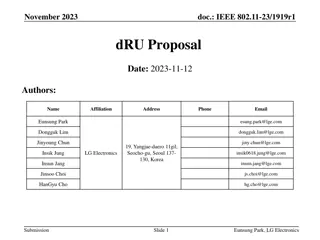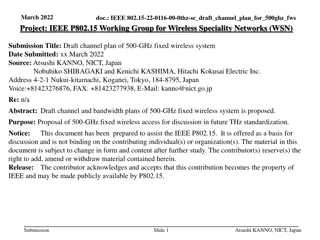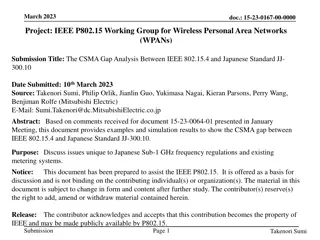Overview of WRC-2023 Results Relevant for THz Communications Project
WRC-2023 decisions impacting THz communications are outlined in this document submitted by Thomas Körner from TU Braunschweig. Changes in radio regulations, new allocations for Radio Location Services, and resolutions on passive and active service compatibility are highlighted, with potential new b
8 views • 10 slides
High-Level Thoughts on Integrated mmWave Communication for WLAN Solutions
Market demands for WLAN solutions supporting high throughput and low latency applications have led to the development of Integrated mmWave (IMMW). This project focuses on integrating the mmwave band with sub-7GHz links to overcome range, mobility, and reliability challenges. IMMW aims to harmonize d
1 views • 7 slides
Bluetooth SIG September 2023 Update on Spectrum Sharing Plans
Bluetooth SIG provided an update on their actions and plans for sharing the 5 and 6 GHz bands with incumbents and unlicensed devices. They aim to collaborate with the Wi-Fi industry to enable equitable sharing for Bluetooth, particularly focusing on the 6 GHz band. The overall plan includes forming
4 views • 8 slides
Improving performance of LBT-enabled NB devices
This submission delves into optimizing the performance of narrowband signals like Bluetooth by utilizing Listen-Before-Talk (LBT) for channel access in the 5 and 6 GHz frequency bands. The study explores the potential advantages for Bluetooth devices in improving efficiency and reliability through L
0 views • 15 slides
Drone Detection Using mmWave Radar for Effective Surveillance
Utilizing mmWave radar technology for drone detection offers solutions to concerns such as surveillance, drug smuggling, hostile intent, and invasion of privacy. The compact and cost-effective mmWave radar systems enable efficient detection and classification of drones, including those with minimal
0 views • 8 slides
Revising ETSI Standard for License-Exempt Operation in 6 GHz Band
Work has commenced on revising the ETSI standard EN 303.687 for license-exempt operation in the 6 GHz band to expedite completion. This revision project outlines the history, New Work Item approval, ETSI processes, and the upcoming steps. It traces back to 2017 when Switzerland and ECC administratio
0 views • 10 slides
Update on Bluetooth SIG's Spectrum Sharing Plans
This update discusses Bluetooth SIG's actions and plans for sharing the 5 and 6 GHz bands with incumbents and unlicensed devices. It highlights the goals, the overall plan, recent actions, and collaboration with the Wi-Fi industry to enable equitable sharing of these bands. The detailed plan involve
0 views • 9 slides
Update on Bluetooth SIG's Plans for Spectrum Sharing in January 2024
Bluetooth SIG presents an update on their actions and plans for sharing the 5 and 6 GHz bands with incumbents and unlicensed devices. Recognizing the need for future growth, they aim to collaborate with the Wi-Fi industry to develop optimal sharing mechanisms in the 6 GHz band. Their plan includes c
0 views • 11 slides
IEEE 802.11-20/0668r1: EHT BSS Configuration Proposal
The document discusses the configuration of a 320 MHz BSS in the context of 6 GHz regulations, focusing on EHT operation elements such as channel width indication, CCFS principles, and BSS advertisement settings. It proposes design principles for managing legacy and EHT STA operations, emphasizing s
0 views • 14 slides
Coexistence Challenges and Solutions in 6 GHz Networks
Various submissions address narrowband (NB) coexistence issues in the 6 GHz frequency band, focusing on Enhanced Detect and Avoid (eDAA) mechanisms to ensure harmonious coexistence between Wi-Fi and NB devices. The proposals discuss channel access rules, interference measurements, simulation results
1 views • 14 slides
Rate Optimization in Wideband RIS-assisted Wireless Systems
This research focuses on rate optimization in wideband RIS-assisted wireless systems, specifically investigating MIMO RIS-assisted systems in sub-6 GHz mmWave settings. Pathloss and blockage modeling, along with LOS vs. spectral efficiency and RIS-UE distance vs. spectral efficiency analyses, are ke
0 views • 4 slides
Clear Channel Assessment (CCA) Behavior of Commercial Wi-Fi Equipment
This document, dated July 2022, delves into the Clear Channel Assessment (CCA) behavior of commercial Wi-Fi equipment in response to Narrowband Frequency Hopping (NB FH) signals. It explores the regulatory framework around license-exempt frequency bands in the USA and Europe, highlighting the specif
0 views • 22 slides
IEEE 802.11 Integrated mmWave Study Group Creation Update
The March 2023 document discusses the formation of the IEEE 802.11 Integrated mmWave Study Group to focus on specifying carrier frequency operation between 42.5 and 71 GHz. The motion for Study Group creation received a mixed response during a meeting. The group aims to develop a new MAC/PHY standar
0 views • 4 slides
PSD-based Energy Detect Threshold (EDT) in ETSI 5 GHz Standard
ETSI BRAN adopted a PSD-based EDT into the 5 GHz standard, specifying thresholds for energy detection levels. The new definition replaces the previous -72 dBm/20 MHz EDT, offering a compromise between power limits and channel configurations. Detailed examples and operational guidelines are provided
0 views • 6 slides
IEEE 802.11-23/1919r1dRU Proposal for Range Extension and RvR Enhancement
This proposal introduces dRU support for 11bn to overcome PSD limitations, enabling range extension and RvR enhancement. It reviews previous dRU contributions in UHR SG and details new proposals including distributed tones across channels, dRU tone plans in different MHz channels, and pilot designs
0 views • 22 slides
Coexistence in 6 GHz License-Exempt Spectrum - IEEE 802.11-19/1083r1
This document discusses the principles and key features of unlicensed spectrum in the 6 GHz frequency band, focusing on coexistence with incumbent services, spectrum efficiency, and regulatory discussions. It also delves into channel access design for 3GPP technologies in the 5 GHz band, highlightin
0 views • 12 slides
Passive Radar for WLAN Sensing in Indoor Scenarios
Radar and CSI have been proposed as potential WLAN sensing techniques. This document focuses on passive radar at 5 GHz in indoor scenarios, discussing background, experimental results, signal processing techniques, and potential impacts on WLAN standards.
6 views • 15 slides
Considerations on PHY for 60 GHz in IEEE 802.11-22/1865r0 Document
The document discusses the possibility of standardizing multi-link (ML) with bands in the sub-7 GHz range combined with bands in the 45-72 GHz range, proposing reusing a sub-7 GHz PHY for mmWave bands. It explores the impact of phase noise on choosing the OFDM numerology for operation in the 45-72 G
1 views • 13 slides
Overview of IEEE 802.11-22/487r0 and EN 301.893 Harmonized Standard
This document discusses the March 2022 version of IEEE 802.11-22/487r0, focusing on the EN 301.893 Harmonized Standard. It covers the confidentiality aspects, accessibility of draft standards, and the implications for manufacturers in the European Union market. The latest version, 2.1.47 of the HS,
5 views • 10 slides
Considerations on 6 GHz Discovery for IEEE 802.11-18/1922r0
IEEE 802.11-18/1922r0 document discusses the background and regulatory context for supporting 6 GHz operation in 802.11ax networks. It focuses on optimizing the discovery process for 6 GHz channels to enhance STA and network KPIs. The typical scanning/discovery procedure for non-AP STAs is outlined,
2 views • 14 slides
Key Coexistence Issues in 5-7 GHz Unlicensed Spectrum for NR Sidelink Evolution
3GPP RAN1 is extending NR sidelink operation to 5-7 GHz unlicensed spectrum, raising concerns about channel access and physical design. Discussions include Listen Before Talk protocols, UE-to-UE COT sharing, and coexistence with WiFi technologies. The study aims to specify support for sidelink on un
0 views • 14 slides
Update on Bluetooth SIG Actions for Spectrum Sharing
This update focuses on Bluetooth SIG's plans to share the 5 and 6 GHz bands with incumbents and unlicensed devices. It discusses the goals, overall plan, recent actions, and collaboration with the Wi-Fi industry to secure the future growth of Bluetooth technology in these bands.
0 views • 9 slides
Understanding Magnetic Shielding Considerations for 3.9 GHz Cavities
This document discusses Q and magnetic shielding considerations for 3.9 GHz cavities used in the LCLS-II project, highlighting the unique behavior observed in nitrogen-treated cavities. The study delves into the improved Q values and field dependence of quality factors, challenging traditional niobi
0 views • 10 slides
802.11aj 45 GHz Channel Access and BSS Operation Framework Proposal
This document outlines a proposal for channel operation and BSS operation in the 45 GHz frequency bands for 802.11aj in China. It includes details on channelization, spectrum allocation, maximum transmit power, and BSS configuration rules. The aim is to meet the functional requirements specified whi
0 views • 32 slides
Cutting-Edge Astrophysics Research at NextBASS: Advancing Sensitivity and Resolution
Cutting-edge research at NextBASS, a collaboration between University of Oxford and Hochschule Munich, aims to cover a frequency gap between 7-30 GHz with advanced technology. The project involves achieving equivalent sensitivity to future cosmic microwave background missions, utilizing multiple fee
0 views • 25 slides
Proposal of TG3d Channel Model for Wireless Backhaul/Fronthaul in IEEE 802.15 Working Group
This document presents a proposal for a TG3d channel model intended for wireless backhaul/fronthaul applications within the IEEE 802.15 Working Group. The proposal addresses operational characteristics, including high path loss mitigation at 300 GHz, requiring high gain antennas for LOS connections.
0 views • 20 slides
Cryogenic Heat Load Measurement and Calibration at IHEP
Researchers at IHEP in Beijing, China, conducted heat load measurements for a 1.3 GHz Cryomodule, analyzing uncertainties in flow rate readings and calibrating mass flow rates. The study involved static and dynamic heat load measurements, utilizing various control interfaces and valves. Calibrations
0 views • 9 slides
Beyond 802.11ad: Ultra High Capacity and Throughput WLAN
The document from January 2014 discusses the exploration of modifications to IEEE 802.11ad-2012 PHY and MAC layers to enable modes of operation in the 60 GHz band capable of achieving a maximum throughput of at least 30 Gbps while maintaining the band's excellent capacity attributes. Topics include
0 views • 21 slides
Parameterized Model for Doppler Spread in mmWave Systems
This document presents a parameterized model for Doppler spread in mmWave systems based on measurements with an 83 GHz channel sounder. The model is linked to the Quasi-deterministic (QD) propagation channel model adopted by the work group. It discusses Doppler frequency shift, channel sounder confi
0 views • 10 slides
IEEE 802.11-16/xxxxr0 August 2016 Discussion Summary
The document discusses comments and proposed resolutions regarding user data, different bands, operation, and latency in IEEE 802.11-16/xxxxr0. Various categories like wake-up packets, band definitions for 2.4 GHz and 5 GHz, radio transitions, and ongoing latency discussions are tackled in this Augu
0 views • 8 slides
Suggested Changes to Enhance LRP UWB with Channel #3
This document presents proposed changes to IEEE802.15.4-2015 to include Channel #3 for enhancing LRP UWB PHY. The aim is to add a 2 GHz bandwidth channel to facilitate operations in countries like Japan and Korea. The background, objectives, and detailed suggestions for these enhancements are outlin
0 views • 18 slides
Update for IEEE 802 by Andy Gowans OFCOM (UK) January 2017
Update on various issues related to IEEE 802 including release of 5.8 GHz in the UK, WRC-19 agenda items, spectrum requirements, consultation responses, and license-exempt spectrum in the UK. Discusses drivers for future demand, DFS, and potential global Wi-Fi band release. Details on bands, user re
0 views • 14 slides
Enhancing Blockage Detection and Handover on 60 GHz Networks with P4 Programmable Data Planes
The study presents a system using programmable switches to monitor packet inter-arrival time for blockage detection on mmWave networks. Results show fast recovery speeds and minimal impact on flow completion time, with contributions focusing on leveraging programmable switches and real device scenar
0 views • 7 slides
Understanding Heating Process in Microwave Oven
Model simulation showcasing the heating process in a microwave oven through electromagnetic analysis and transient heat transfer. Explore how heat redistributes in a potato placed inside the oven at 2.45 GHz frequency. Analyze the absorbed power, microwave distribution, and temperature evolution ove
0 views • 10 slides
2.4 GHz CubeSat Communications System Overview
The 2.4 GHz CubeSat Communications System, led by Robert Bui, aims to establish a reliable data link between the SDS-1 Cube Satellite and the ASU ground station. Operating on the 13 cm amateur ham radio band at frequencies of 2400-2450 MHz, the system utilizes a Transceiver (MHX-2420) with a link ra
0 views • 10 slides
Draft Channel Plan of 500-GHz Fixed Wireless System for Ultra-High-Definition Surveillance
Proposed is a draft channel plan for a 500-GHz fixed wireless system suitable for ultra-high-definition surveillance applications in smart industries and public transportation. This system aims to enable high-capacity data transmission with low spectrum interference in short-distance links, offering
0 views • 10 slides
Relevance of Lean PHY for EHT in 6 GHz
Discussing the importance of a Lean PHY for EHT in 6 GHz to improve spectrum efficiency and reduce overhead. Introducing the Low Throughput PHY as a potential solution, highlighting its benefits compared to existing options like 802.11a. Measurement results show the impact and potential for enhancin
0 views • 14 slides
Next-Generation 60 GHz Peak Data Rate Technologies
This presentation delves into the exploration of potential technologies to meet the peak data rate requirements of NG-60, focusing on enhancements to IEEE 802.11 physical and medium access control layers. Various channel bonding scenarios and achievable peak data rates are discussed, aiming to reach
0 views • 9 slides
CSMA Gap Analysis Between IEEE 802.15.4 and Japanese Standard JJ-300.10
This document analyzes the differences in CSMA protocol and performance between IEEE 802.15.4 and Japanese Standard JJ-300.10, focusing on unique issues related to Japanese Sub-1 GHz frequency regulations and metering systems. With increasing data traffic and channel access demands, insights are pro
0 views • 19 slides
Understanding Millimeter Wave Regulation and FCC Restricted Bands
Overview of millimeter wave regulation by IEEE and FCC, including restricted bands, radar rules, advantages and disadvantages of millimeter wave signals, and FCC rules on restricted bands above 38.6 GHz. Details on communication bands, power regulations, and proposals for unlicensed usage in the 57-
0 views • 19 slides







































